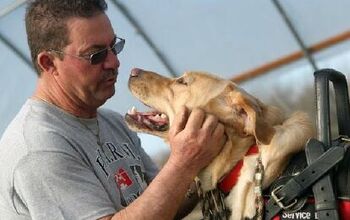New Device Allows The Blind To Monitor Their Guide Dog

There’s no mistaking when our pooch is feeling under the weather. He’s listless, slow to respond to our call and often off his food. Whoever coined the term “hang-dog” sure had him pegged and for most of us, the first clue that something is amiss is certainly his mood and appearance. So what do you do when you’re visually impaired and these cues aren’t as easy to spot?
Well, research led by Sean Mealin, a PhD student at North Carolina State University is already leading the proverbial pack in this regard and it has resulted in a device that will allow blind pet parents to monitor the health of their guide dogs.
Related: Amazing New Harness Helps Dogs And Humans Communicate
As explained by Assistant Professor of Computer Science at NC State and co-author of the paper David Roberts, an ailing guide dog is particularly challenging to identify because they are trained to remain calm and retain a placid, easy-going demeanor.
With this new suite of technologies a dog’s breathing and heart rate can be monitored and information shared with his handler, eliminating the need for visual indicators.
Related: Voyce Health Monitor
According to Mealin,”Our goal is to let guide dog handlers know when their dogs are stressed or anxious. This is important because it is widely believed that stress is a significant contributing factor to early retirement of guide dogs and other service animals. The technology may also be able to help handlers detect other health problems, such as symptoms of heat exhaustion.”
What drove Mealin to pursue this particular issue is a personal one. He too is visually impaired and works with his own guide dog, Simba. While previous research had produced a lightweight harness that could capture information, the question was how to share this data with the handler in a manner that would allow them to act on it.
The solution was to create a special handle that attached to the guide dog’s harness and was equipped with two vibrating motors. One motor is embedded in the handle by the handler’s thumb, and vibrates – or beats – in time with the dog’s heart rate. When the dog’s heart rate increases, so does the rate at which the motor beats.
The second motor is located near the handler’s pinky finger, and vibrates in sync with the dog’s breathing. The vibration increases and decreases in intensity, to simulate the dog breathing in and out.
A proto-type version has been tested and found effective at conveying accurate, easy-to-read info to the handler. While Roberts confirms the final design won’t be available in the “immediate future”, their ultimate goal is to provide technology that can help guide dogs and aid their handlers in a user-friendly manner.
Source: [ Science Daily]

Sharing space with three seriously judgy Schnoodles and a feline who prefers to be left alone. #LivingMyBestLife
More by Mary Simpson
























